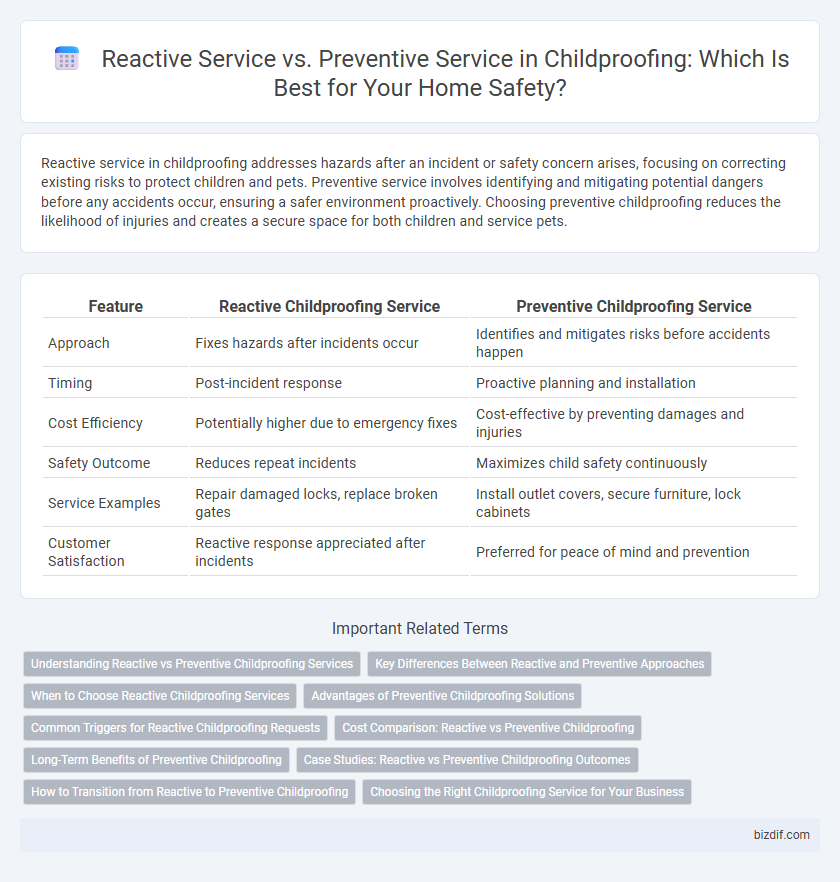Reactive service in childproofing addresses hazards after an incident or safety concern arises, focusing on correcting existing risks to protect children and pets. Preventive service involves identifying and mitigating potential dangers before any accidents occur, ensuring a safer environment proactively. Choosing preventive childproofing reduces the likelihood of injuries and creates a secure space for both children and service pets.
Table of Comparison
| Feature | Reactive Childproofing Service | Preventive Childproofing Service |
|---|---|---|
| Approach | Fixes hazards after incidents occur | Identifies and mitigates risks before accidents happen |
| Timing | Post-incident response | Proactive planning and installation |
| Cost Efficiency | Potentially higher due to emergency fixes | Cost-effective by preventing damages and injuries |
| Safety Outcome | Reduces repeat incidents | Maximizes child safety continuously |
| Service Examples | Repair damaged locks, replace broken gates | Install outlet covers, secure furniture, lock cabinets |
| Customer Satisfaction | Reactive response appreciated after incidents | Preferred for peace of mind and prevention |
Understanding Reactive vs Preventive Childproofing Services
Reactive childproofing services address safety hazards after incidents or near-misses have occurred, focusing on immediate risk mitigation to prevent further accidents. Preventive childproofing services involve proactive assessments and modifications designed to eliminate potential dangers before any incidents arise, ensuring a safer environment from the outset. Understanding the distinction between these approaches allows parents and caregivers to choose effective strategies that either respond to existing risks or create a secure space preemptively.
Key Differences Between Reactive and Preventive Approaches
Reactive childproofing service addresses hazards after incidents occur, focusing on immediate fixes to prevent recurrence. Preventive service proactively identifies and mitigates potential risks before any accidents happen, ensuring a safer environment for children. Key differences lie in timing, with reactive measures responding to actual events and preventive strategies emphasizing early intervention and risk assessment.
When to Choose Reactive Childproofing Services
Reactive childproofing services are essential when an incident has already occurred, such as a child injury or near-miss that reveals specific hazards in the home environment. Families should choose reactive services to address immediate safety concerns by quickly securing hazardous areas or items based on observed risks. These services provide targeted solutions that mitigate further danger while preventing recurrence of similar accidents.
Advantages of Preventive Childproofing Solutions
Preventive childproofing solutions significantly reduce the risk of accidents by addressing potential hazards before children encounter them, ensuring a safer environment at all times. These proactive measures include installing safety gates, outlet covers, and securing furniture, which help avoid injuries and costly emergency interventions. Investing in preventive childproofing not only promotes peace of mind for parents but also supports long-term safety and well-being for children.
Common Triggers for Reactive Childproofing Requests
Common triggers for reactive childproofing requests include sudden hazards like exposed electrical outlets, unsecured furniture, and accessible sharp objects discovered after incidents or near misses. These urgent needs arise when a child's curiosity exposes immediate safety risks that were previously unnoticed. Preventive childproofing anticipates such dangers by installing outlet covers, securing heavy items, and removing choking hazards before accidents occur.
Cost Comparison: Reactive vs Preventive Childproofing
Reactive childproofing services typically incur higher costs due to emergency repairs, medical expenses from accidents, and potential property damage. Preventive childproofing involves an upfront investment in safety devices and modifications that reduce the likelihood of injuries, ultimately lowering long-term expenses. Investing in preventive measures leads to significant cost savings by minimizing the need for costly reactive interventions and medical treatments.
Long-Term Benefits of Preventive Childproofing
Preventive childproofing reduces the risk of accidents by addressing hazards before incidents occur, ensuring a safer environment for children over time. This proactive approach minimizes medical expenses and emotional distress associated with injuries, supporting sustained family well-being. Investing in preventive measures creates lasting safety solutions that adapt as children grow, offering continuous protection.
Case Studies: Reactive vs Preventive Childproofing Outcomes
Case studies reveal significant differences between reactive and preventive childproofing outcomes, with preventive measures reducing injury rates by up to 70%. Reactive services often address hazards post-incident, leading to higher medical costs and repeated safety failures. Data supports that preventive childproofing not only enhances long-term safety but also lowers emergency interventions and parental stress.
How to Transition from Reactive to Preventive Childproofing
Transitioning from reactive to preventive childproofing involves assessing potential hazards before incidents occur and implementing safety measures proactively, such as installing safety gates and outlet covers early. Parents and caregivers should regularly conduct home safety audits and educate themselves on child development stages to anticipate risks effectively. Engaging professional childproofing services for comprehensive evaluations ensures a safer environment and reduces the need for emergency fixes.
Choosing the Right Childproofing Service for Your Business
Choosing the right childproofing service for your business requires understanding the difference between reactive and preventive approaches. Reactive services address safety hazards after incidents occur, while preventive services proactively identify and mitigate risks before accidents happen, ensuring a safer environment. Prioritizing preventive childproofing reduces liability and fosters trust with clients by demonstrating a commitment to child safety.
Reactive service vs Preventive service Infographic

 bizdif.com
bizdif.com